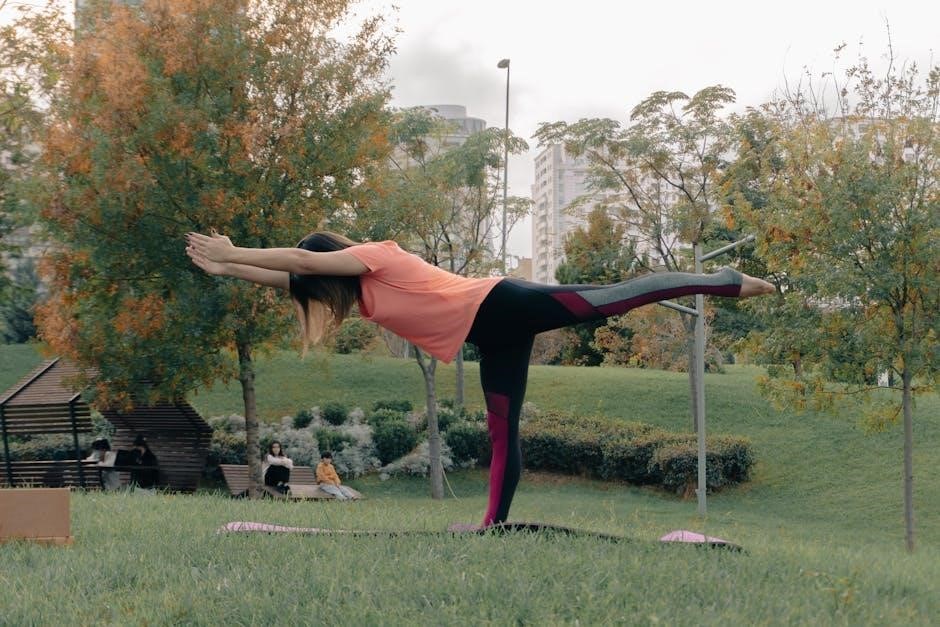Shin splints are a common injury causing pain in the lower leg, often due to overuse or repetitive stress, significantly impacting athletes’ performance and training consistency.
Understanding Shin Splints: Definition and Common Causes
Shin splints, or medial tibial stress syndrome, refer to pain along the inner edge of the shinbone, often caused by overuse or repetitive stress on the lower leg. Common causes include sudden increases in training intensity, improper footwear, or muscle imbalances in the calf and shin. Activities like running, especially on hard surfaces, can exacerbate the condition. Tightness in the anterior tibialis muscle and poor foot mechanics also contribute. Unlike stress fractures, shin splints typically present as diffuse pain rather than sharp, localized discomfort. Addressing these factors early is crucial to prevent progression and promote recovery, ensuring athletes can maintain their training routines effectively;
The Importance of Addressing Shin Splints for Long-Term Athletic Health
Neglecting shin splints can lead to chronic pain and prolonged recovery, hindering athletic performance and overall health. Addressing the issue early is vital to prevent it from escalating into more severe injuries, such as stress fractures. Strengthening exercises, proper rest, and modifications in training routines can significantly reduce the risk of recurrence. Additionally, incorporating specific stretches and cross-training activities helps maintain fitness while allowing the lower leg to heal. By prioritizing recovery and adopting preventive measures, athletes can ensure long-term health and sustain their active lifestyles without constant setbacks from shin-related pain.

Causes and Risk Factors of Shin Splints
Shin splints often result from overuse, repetitive stress, and muscle imbalances. Poor footwear, uneven training surfaces, and sudden changes in activity intensity also contribute to their development.
Overuse and Repetitive Stress on the Lower Leg
Overuse and repetitive stress are primary contributors to shin splints, often occurring in athletes who suddenly increase their training intensity or duration. Activities like running, especially on hard surfaces, can cause repetitive impact on the tibia and surrounding muscles. This stress leads to inflammation and pain along the shin bone. Prolonged or excessive activity without adequate recovery time exacerbates the condition, making it challenging for the lower leg to heal. Addressing overuse involves modifying training routines, incorporating rest periods, and strengthening exercises to reduce strain on the affected areas. Proper management is crucial to prevent chronic issues and ensure long-term athletic health.
Muscle Imbalances and Tightness in the Calf and Shin
Muscle imbalances and tightness in the calf and shin are significant contributors to shin splints. Tightness in the anterior tibialis muscle can pull on the shin bone, causing pain and inflammation. Weak or overly tight calf muscles disrupt the lower leg’s biomechanics, leading to overcompensation and strain on the shin. Strengthening exercises for the calf and shin, along with targeted stretches, can help restore balance and reduce tension. Addressing these imbalances is crucial for both prevention and recovery, as they often exacerbate the repetitive stress associated with shin splints. Proper management involves a combination of strengthening, stretching, and modifying training routines to alleviate discomfort and promote long-term athletic health.
The Role of Footwear and Training Surfaces
Footwear and training surfaces play a crucial role in the development and prevention of shin splints. Wearing unsupportive or worn-out shoes can increase stress on the shin bone and surrounding muscles, leading to pain and inflammation. Similarly, training on hard or uneven surfaces can exacerbate the issue by applying additional force to the lower leg. Proper footwear with adequate arch support and cushioning can help redistribute this stress, reducing the risk of injury. Additionally, gradually adapting to new training surfaces or routines can minimize the likelihood of overuse injuries. Addressing these factors is essential for both prevention and recovery, as they directly impact the biomechanics and comfort of the lower leg during physical activity.
Symptoms and Diagnosis of Shin Splints
Shin splints cause pain along the inner or front of the shin, often sharp or nagging, linked to overuse. Diagnosis involves physical exams and sometimes imaging to rule out fractures or stress fractures, focusing on activity history and pain location.
Identifying Pain Locations: Medial vs. Anterior Shin Splints
Medial shin splints cause pain along the inner edge of the tibia, often a dull ache worsening with activity, while anterior shin splints affect the front outer edge, typically sharper and linked to overuse or sudden activity changes.
Distinguishing Shin Splints from Other Lower Leg Injuries
Shin splints differ from stress fractures, which cause localized, severe pain and persist even at rest. Unlike compartment syndrome, shin splints don’t typically cause swelling or tightness in the muscle compartments. Pain from shin splints is usually a dull ache along the shinbone, while Achilles tendonitis affects the back of the heel. Accurate diagnosis is crucial for effective treatment, as misidentifying shin splints can delay recovery or worsen the condition. Consulting a healthcare professional for a proper evaluation ensures appropriate management and prevents further complications.

Prevention and Management Strategies
Combining rest, strengthening exercises, and targeted stretches helps manage shin splints. Incorporating cross-training and proper footwear can prevent recurrence and support long-term recovery effectively.
The Role of Rest and Recovery in Healing
Rest and recovery are crucial for healing shin splints, allowing the inflamed tissues to repair. Avoiding high-impact activities and incorporating low-intensity exercises like swimming or cycling can aid recovery. Proper rest helps prevent further strain, reducing the risk of chronic pain. Gradually reintroducing activities ensures the lower leg muscles and bones heal adequately. Ignoring the need for rest can lead to prolonged recovery or more severe injuries. Balancing rest with gentle stretches and strengthening exercises supports a faster return to normal training. Patience is key, as rushing back can exacerbate the condition and delay healing.
Strengthening Exercises for the Calf and Shin Muscles
Strengthening the calf and shin muscles is essential for reducing shin splint pain and preventing recurrence. Exercises like calf raises, toe raises, and heel drops target the muscles around the shin, improving their endurance and stability. Incorporating resistance bands or light weights can enhance the effectiveness of these exercises. Consistency is key, as weak muscles contribute to strain and pain. Regular strengthening routines help redistribute the stress of high-impact activities, reducing pressure on the shin bone. Over time, this can lead to faster recovery and improved athletic performance. Combining these exercises with proper rest and stretching creates a comprehensive approach to managing shin splints effectively.

Proper Footwear and Training Modifications
Wearing supportive footwear with adequate arch support and cushioning is crucial for reducing shin splint discomfort. Shoes with proper alignment and shock absorption help distribute stress evenly, minimizing strain on the lower leg. Additionally, modifying training routines, such as reducing mileage or avoiding hard surfaces, can alleviate pain. Gradually increasing activity levels and incorporating cross-training with low-impact exercises, like cycling or swimming, can help the body adapt without overloading the shins. Ensuring footwear is not worn out and replacing it regularly further supports injury prevention. These adjustments, combined with consistent strengthening and stretching, create a balanced approach to managing shin splints and promoting long-term recovery.

Cross-Training and Low-Impact Activities
Cross-training with low-impact activities like swimming, cycling, or elliptical workouts can significantly reduce stress on the shins while maintaining fitness levels. These exercises allow athletes to avoid repetitive impact, giving the lower leg muscles time to heal and strengthen. Incorporating activities that don’t involve running or jumping helps prevent overuse injuries and supports overall recovery. Many find that alternating between high-impact sports and low-impact training not only aids in injury prevention but also enhances flexibility and endurance. By diversifying their routines, athletes can address shin splint discomfort effectively without compromising their training progress or performance goals.
Effective Stretches for Shin Splints
Targeted stretches like the big toe stretch, hero pose, and ankle flexion can alleviate shin splint pain by improving flexibility and reducing muscle tension in the lower leg.
Big Toe Stretch: Targeting the Anterior Tibialis Muscle
The big toe stretch is a simple yet effective exercise for shin splints, focusing on the anterior tibialis muscle; Sit or stand, and gently pull your big toe back toward your shin to stretch the top of your foot and shin area. This stretch reduces pressure on the tibia, elongates the anterior tibialis muscle, and enhances ankle mobility. It can be done during breaks or post-workout, making it a convenient addition to daily routines. Regular practice helps alleviate shin splint pain and prevents recurrence by maintaining flexibility and strength in the lower leg muscles.

Hero Pose: A Yoga-Based Stretch for Shin and Ankle Mobility
The Hero Pose, or Virasana, is a yoga-based stretch that targets the shin and ankle muscles, improving mobility and reducing tension. Kneel on the floor with your knees slightly apart and toes pointed backward. Sit back between your heels, stretching the front of your shins. For deeper intensity, lean back slightly or lift your arms overhead. This stretch is ideal for post-workout or as part of a maintenance routine to enhance flexibility and alleviate shin splint discomfort. Regular practice helps strengthen the muscles around the shin bone, promoting long-term relief and preventing future injuries.
Ankle Flexion: Improving Ankle Mobility and Reducing Tension
Ankle flexion is a dynamic stretch that enhances mobility and reduces tension in the lower leg, particularly beneficial for shin splints. Sit or stand, then lift your heels off the ground, flexing your ankles upward. Hold for 5-10 seconds, repeat 10-15 times. This exercise strengthens the anterior tibialis muscle, alleviating shin pain and improving flexibility. Regular practice can prevent shin splint recurrence by balancing muscle tension and enhancing blood flow. Incorporate ankle flexion into your warm-up or cool-down routine for optimal results and long-term injury prevention.
Wall Hip Flexor Stretch: Enhancing Flexibility and Reducing Strain

The wall hip flexor stretch targets the hip flexors, which play a crucial role in lower leg mechanics. Stand facing a wall with one hand on it for balance. Bend one knee, keeping the foot behind you, and press your hips forward until a stretch is felt in the front of your hip. Hold for 20-30 seconds, then switch sides. This stretch improves hip flexibility, reduces strain on the shin muscles, and helps prevent shin splints by addressing muscle imbalances. Regular practice enhances overall lower body alignment and movement efficiency, making it an essential addition to any shin splint prevention routine.
Tibial Torque: A Dynamic Stretch for Shin and Calf Muscles
Tibial torque is a dynamic stretch that targets the shin and calf muscles, enhancing flexibility and reducing muscle tension. To perform, sit with legs extended, loop a resistance band around the feet, and gently twist the ankles inward and outward. This motion activates the tibialis anterior and calf muscles, improving circulation and reducing stiffness. Regular practice helps alleviate shin splint discomfort by strengthening the lower leg muscles and improving joint mobility. Incorporate this stretch into your warm-up or maintenance routine to prepare for physical activity and support long-term injury prevention. Its dynamic nature makes it ideal for athletes seeking to enhance performance and reduce the risk of overuse injuries.
Toe Taps and Calf Rolls: Simple Exercises for Daily Maintenance
Toe taps and calf rolls are simple yet effective exercises for daily maintenance, targeting the muscles around the shins and calves. Toe taps involve lifting the heels slightly while tapping the toes, promoting ankle mobility and reducing stiffness. Calf rolls require rolling a hard object, like a water bottle, over the calf muscles to release tension and improve circulation. These exercises are ideal for preventing shin splints and can be done anywhere, making them a convenient addition to any routine. Regular practice helps maintain muscle flexibility and strength, reducing the risk of overuse injuries and enhancing overall lower leg health for athletes and individuals alike.
Consistent routines, patience, and gradual progression are key to long-term recovery. Combining rest, strengthening exercises, and proper stretching techniques ensures sustained healing and prevents future shin splint issues.
Creating a Consistent Routine for Prevention and Recovery
Establishing a daily routine is crucial for managing shin splints. Incorporate stretches like the big toe stretch and hero pose to target the anterior tibialis and improve ankle mobility. Strengthening exercises, such as toe taps and calf rolls, should be done 2-3 times weekly. Dynamic warm-ups before workouts and static stretches post-exercise help maintain muscle balance. Consistency is key; even simple exercises, when performed regularly, can significantly reduce the risk of recurrence. Over time, this routine becomes a preventive measure, ensuring long-term recovery and allowing athletes to return to their activities without discomfort.
The Importance of Patience and Gradual Progression in Healing
Patience is vital when recovering from shin splints, as rushing back into activity can worsen the injury. Gradual progression ensures the lower leg muscles and bones heal properly. Start with low-impact exercises like swimming or cycling, then slowly reintroduce running or high-impact activities. Strengthening and stretching routines should be consistent but gentle, avoiding overexertion. Listening to your body and adhering to a structured recovery plan prevents setbacks. Over time, this approach rebuilds strength and flexibility, reducing the risk of future injuries and allowing athletes to return to peak performance safely.

Additional Resources for Shin Splint Relief
Downloadable PDF guides and workout plans offer structured approaches to healing. Expert tips from physical therapists and trainers provide tailored advice for effective recovery and prevention strategies.
Recommended PDF Guides and Workout Plans
PDF guides and workout plans are excellent resources for managing shin splints. They often include detailed stretching routines, strengthening exercises, and recovery tips tailored for athletes. These guides emphasize the importance of gradual progression and proper form to prevent overuse injuries. Many plans incorporate dynamic stretches like the big toe stretch and hero pose, which target the anterior tibialis and improve ankle mobility. Strengthening exercises for the calf and shin muscles are also highlighted, along with cross-training activities such as cycling and swimming. By following these structured plans, athletes can effectively reduce pain, enhance flexibility, and promote long-term recovery. Consistency is key to achieving lasting results.
Expert Tips from Physical Therapists and Trainers
Physical therapists and trainers recommend a multi-faceted approach to managing shin splints, combining strengthening, stretching, and recovery strategies. They emphasize the importance of dynamic stretches during warm-ups and static stretches post-workout to maintain lower leg flexibility. Strengthening exercises, such as those targeting the anterior tibialis, can reduce strain on the shin bone. Experts also suggest incorporating cross-training activities like swimming or cycling to minimize stress on the lower legs. Patience and gradual progression are key, as overloading the body can exacerbate symptoms. By following these expert tips, athletes can effectively manage shin splints and prevent future occurrences, ensuring long-term recovery and performance.

